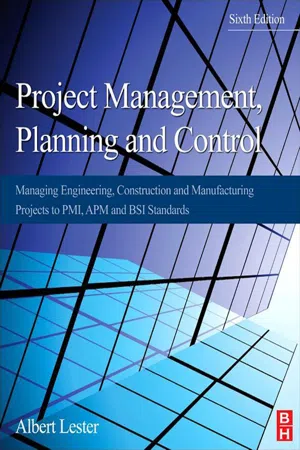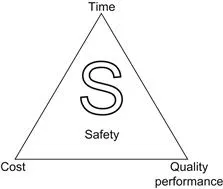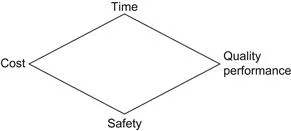
Project Management, Planning and Control
Managing Engineering, Construction and Manufacturing Projects to PMI, APM and BSI Standards
- 592 pages
- English
- ePUB (mobile friendly)
- Available on iOS & Android
Project Management, Planning and Control
Managing Engineering, Construction and Manufacturing Projects to PMI, APM and BSI Standards
About this book
Covering the principles and techniques you need to successfully manage an engineering or technical project from start to finish, Project Management, Planning and Control is an established and widely recommended project management handbook.With clear and detailed coverage of planning, scheduling and control, which can pose particular challenges in engineering environments, this sixth edition includes new chapters on Agile project management and project governance, more real-life examples and updated software information.Ideal for those studying for Project Management Professional (PMP) qualifications, Project Management, Planning and Control is aligned with the latest Project Management Body of Knowledge (PMBOK) for both the Project Management Institute (PMI) and the Association of Project Management (APM), and includes questions and answers to help you test your understanding. It is also updated to match the latest BS 6079 standard for project management in construction.- Focused on the needs and challenges of project managers in engineering, manufacturing and construction, and closely aligned to the content of the APM and PMI 'bodies of knowledge'.- Structured according to the logical sequence of a major project, with a strong focus on planning, scheduling, budgeting, and control—critical elements in the management of engineering projects.- Includes project management questions and answers, compiled by a former APM exam assessor, to help you test your knowledge and prepare for professional examinations.
Frequently asked questions
- Essential is ideal for learners and professionals who enjoy exploring a wide range of subjects. Access the Essential Library with 800,000+ trusted titles and best-sellers across business, personal growth, and the humanities. Includes unlimited reading time and Standard Read Aloud voice.
- Complete: Perfect for advanced learners and researchers needing full, unrestricted access. Unlock 1.4M+ books across hundreds of subjects, including academic and specialized titles. The Complete Plan also includes advanced features like Premium Read Aloud and Research Assistant.
Please note we cannot support devices running on iOS 13 and Android 7 or earlier. Learn more about using the app.
Information
Project Definition
Abstract
Keywords
Project Definition



Time-Bound Project
Cost-Bound Project
Performance (Quality)-Bound Project
Safety-Bound Project
Table of contents
- Cover image
- Title page
- Table of Contents
- Copyright
- Preface
- Foreword to the First Edition
- Acknowledgements
- Chapter 1. Project Definition
- Chapter 2. Project Management
- Chapter 3. Programme and Portfolio Management
- Chapter 4. Project Context (Project Environment)
- Chapter 5. Business Case
- Chapter 6. Investment Appraisal
- Chapter 7. Stakeholder Management
- Chapter 8. Project Success Criteria
- Chapter 9. Organization Structures
- Chapter 10. Organization Roles
- Chapter 11. Project Life Cycles
- Chapter 12. Work Breakdown Structures
- Chapter 13. Estimating
- Chapter 14. Project Management Plan
- Chapter 15. Risk Management
- Chapter 16. Quality Management
- Chapter 17. Change Management
- Chapter 18. Configuration Management
- Chapter 19. Basic Network Principles
- Chapter 20. Planning Blocks and Subdivision of Blocks
- Chapter 21. Arithmetical Analysis and Floats
- Chapter 22. The Case for Manual Analysis
- Chapter 23. Lester Diagram
- Chapter 24. Graphical and Computer Analysis
- Chapter 25. Milestones and Line of Balance
- Chapter 26. Simple Examples
- Chapter 27. Progress Reporting
- Chapter 28. Project Management and Network Planning
- Chapter 29. Network Applications Outside the Construction Industry
- Chapter 30. Resource Loading
- Chapter 31. Cash Flow Forecasting
- Chapter 32. Cost Control and EVA
- Chapter 33. Control Graphs and Reports
- Chapter 34. Procurement
- Chapter 35. Value Management
- Chapter 36. Health and Safety and Environment
- Chapter 37. Information Management
- Chapter 38. Communication
- Chapter 39. Team Building and Motivation
- Chapter 40. Leadership
- Chapter 41. Negotiation
- Chapter 42. Conflict Management and Dispute Resolution
- Chapter 43. Governance
- Chapter 44. Project Close-Out and Handover
- Chapter 45. Project Close-Out Report and Review
- Chapter 46. Stages and Sequence
- Chapter 47. Worked Example 1: Bungalow
- Chapter 48. Worked Example 2: Pumping Installation
- Chapter 49. Worked Example 3: Motor Car
- Chapter 50. Worked Example 4: Battle Tank
- Chapter 51. Primavera P6
- Chapter 52. BIM
- Appendix 1. Agile Project Management
- Appendix 2. Abbreviations and Acronyms Used in Project Management
- Appendix 3. Glossary
- Appendix 4. Examination Questions 1: Questions
- Appendix 5. Bibliography
- Appendix 6. Words of Wisdom
- Index
- Appendix 7. Sample examination questions